Les interventions destinées à augmenter la consommation de fruits et légumes chez les enfants âgés de cinq ans ou moins
Appendices
Appendix 1. Cochrane's living systematic review pilots
Living systematic reviews offer a new approach to review updating in which the review is continually updated, incorporating relevant new evidence as it becomes available (Elliott (in press)). Cochrane is exploring the feasibility of preparing and publishing living systematic reviews in a series of pilots, which includes this review. For the Cochrane pilots, searching is being conducted monthly, and we will incorporate new relevant evidence (studies, data or other information) into the review in a timely manner, so that the findings of the review remain current.
For the most up‐to‐date information about the review, the results of the searches and any new evidence being incorporated, we encourage readers to check the update status information. We will revise the update status information whenever the searches are re‐run. We will update the review with a new citation whenever we find a new trial, or relevant information about already‐included trials (e.g. new outcome data).
Appendix 2. Search strategies
CENTRAL
#1 MeSH descriptor Fruit explode all trees
#2 MeSH descriptor Citrus explode all trees
#3 MeSH descriptor Vegetables explode all trees
#4 fruit*
#5 vegetable*
#6 orange*
#7 apple*
#8 (pear or pears)
#9 (grape or grapes)
#10 banana*
#11 (berry or berries):ti,ab,kw
#12 citrus
#13 carrot*
#14 "greens"
#15 cabbage*
#16 brassica*
#17 blackberr*
#18 blueberr*
#19 cranberr*
#20 kiwi*
#21 guava*
#22 lingonberr*
#23 mango*
#24 melon*
#25 papaya*
#26 pineapple*
#27 raspberr*
#28 strawberr*
#29 tomato*
#30 grapefruit*
#31 mandarin*
#32 satsuma*
#33 tangerine*
#34 (plum or plums)
#35 apricot*
#36 (cherry or cherries)
#37 nectarine*
#38 (peach or peaches)
#39 celery
#40 spinach*
#41 (salad or salads)
#42 (pea or peas)
#43 (bean or beans)
#44 broccoli
#45 cauliflower*
#46 beetroot*
#47 (turnip* or potato* or onion*)
#48 rhubarb
#49 MeSH descriptor Food Habits, this term only
#50 MeSH descriptor Food Preferences, this term only
#51 (health* next eating) or (food next habit*) or (food next preference*) or (eating next habit*) or (eating next preference*) or (eating next behavi*)
#52 (#1 OR #2 OR #3 OR #4 OR #5 OR #6 OR #7 OR #8 OR #9 OR #10)
#53 (#11 OR #12 OR #13 OR #14 OR #15 OR #16 OR #17 OR #18 OR #19 OR #20)
#54 (#21 OR #22 OR #23 OR #24 OR #25 OR #26 OR #27 OR #28 OR #29 OR #30)
#55 (#31 OR #32 OR #33 OR #34 OR #35 OR #36 OR #37 OR #38 OR #39 OR #40)
#56 (#41 OR #42 OR #43 OR #44 OR #45 OR #46 OR #47 OR #48 OR #49 OR #50 OR #51)
#57 (#52 OR #53 OR #54 OR #55 OR #56)
#58 MeSH descriptor Health Education explode all trees
#59 MeSH descriptor Health Promotion explode all trees
#60 MeSH descriptor Behavior Therapy explode all trees
#61 MeSH descriptor Counseling explode all trees
#62 MeSH descriptor Organizational Policy, this term only
#63 MeSH descriptor Public Policy, this term only
#64 MeSH descriptor Health Policy explode all trees
#65 MeSH descriptor Inservice Training explode all trees
#66 promot*
#67 educat*
#68 program*
#69 (policy or policies)
#70 train*
#71 (diet* near/6 intervention*)
#72 (behavi* near/6 intervention*)
#73 (#58 OR #59 OR #60 OR #61 OR #62 OR #63 OR #64 OR #65 OR #66)
#74 (#67 OR #68 OR #69 OR #70 OR #71 OR #72)
#75 (#73 OR #74)
#76 MeSH descriptor Infant explode all trees
#77 MeSH descriptor Child, Preschool, this term only
#78 (child or children)
#79 (pre‐school* or preschool*)
#80 (infant or infants or infancy)
#81 (nursery or nurseries or kindergarten)
#82 MeSH descriptor Parents explode all trees
#83 (parent or parents)
#84 (toddler* or baby or babies)
#85 MeSH descriptor Nurseries, this term only
#86 (#76 OR #77 OR #78 OR #79 OR #80 OR #81 OR #82 OR #83 OR #84 OR #85)
#87 (#57 AND #75 AND #86)
MEDLINE (Ovid)
1. exp Fruit/
2. exp Citrus/
3. exp Vegetables/
4. fruit*.tw.
5. vegetable*.tw.
6. orange*.tw.
7. apple*.tw.
8. (pear or pears).tw.
9. (grape or grapes).tw.
10. banana*.tw.
11. (berry or berries).tw.
12. citrus.tw.
13. carrot*.tw.
14. greens.tw.
15. cabbage*.tw.
16. brassica*.tw.
17. blackberr*.tw.
18. blueberr*.tw.
19. cranberr*.tw.
20. guava*.tw.
21. kiwi*.tw.
22. lingonberr*.tw.
23. mango*.tw.
24. melon*.tw.
25. papaya*.tw.
26. pineapple*.tw.
27. raspberr*.tw.
28. strawberr*.tw.
29. tomato*.tw.
30. potato*.tw.
31. onion*.tw.
32. grapefruit*.tw.
33. mandarin*.tw.
34. satsuma*.tw.
35. tangerine*.tw.
36. (plum or plums).tw.
37. apricot*.tw.
38. (cherry or cherries).tw.
39. nectarine*.tw.
40. (peach or peaches).tw.
41. celery.tw.
42. spinach*.tw.
43. (salad or salads).tw.
44. (pea or peas).tw.
45. (bean or beans).tw.
46. broccoli.tw.
47. cauliflower*.tw.
48. beetroot*.tw.
49. turnip*.tw.
50. rhubarb.tw.
51. Food Habits/
52. Food Preferences/
53. ((food or eating) adj (habit* or preference*)).tw.
54. eating behavi*.tw.
55. (health* adj eating).tw.
56. or/1‐55
57. exp Health Education/
58. exp Health Promotion/
59. exp Behavior Therapy/
60. exp Counseling/
61. organizational policy/
62. Public Policy/
63. exp Health Policy/
64. exp Inservice Training/
65. promot*.tw.
66. educat*.tw.
67. program*.tw.
68. (policy or policies).tw.
69. train*.tw.
70. (diet* adj6 intervention*).tw.
71. (behavi* adj6 intervention*).tw.
72. or/57‐71
73. exp Infant/
74. Child, Preschool/
75. (child or children).tw.
76. (pre‐school* or preschool*).tw.
77. (infant or infants).tw.
78. infancy.tw.
79. (nursery or nurseries).tw.
80. exp Parents/
81. (parent or parents).tw.
82. toddler*.tw.
83. Nurseries/
84. (baby or babies).tw.
85. or/73‐84
86. 56 and 72 and 85
87. randomized controlled trial.pt.
88. controlled clinical trial.pt.
89. randomized.ab.
90. placebo.ab.
91. drug therapy.fs.
92. randomly.ab.
93. trial.ab.
94. groups.ab.
95. 87 or 88 or 89 or 90 or 91 or 92 or 93 or 94
96. exp animals/ not humans.sh.
97. 95 not 96
98. 86 and 97
Embase Classic and Embase (Ovid)
1. exp Fruit/
2. exp Vegetables/
3. fruit*.tw.
4. vegetable*.tw.
5. orange*.tw.
6. apple*.tw.
7. (pear or pears).tw.
8. (grape or grapes).tw.
9. banana*.tw.
10. (berry or berries).tw.
11. citrus.tw.
12. carrot*.tw.
13. greens.tw.
14. cabbage*.tw.
15. brassica*.tw.
16. blackberr*.tw.
17. blueberr*.tw.
18. cranberr*.tw.
19. guava*.tw.
20. kiwi*.tw.
21. lingonberr*.tw.
22. mango*.tw.
23. melon*.tw.
24. papaya*.tw.
25. pineapple*.tw.
26. raspberr*.tw.
27. strawberr*.tw.
28. tomato*.tw.
29. grapefruit*.tw.
30. mandarin*.tw.
31. satsuma*.tw.
32. tangerine*.tw.
33. (plum or plums).tw.
34. apricot*.tw.
35. (cherry or cherries).tw.
36. nectarine*.tw.
37. (peach or peaches).tw.
38. celery.tw.
39. spinach*.tw.
40. (salad or salads).tw.
41. (pea or peas).tw.
42. (bean or beans).tw.
43. onion*.tw.
44. broccoli.tw.
45. cauliflower*.tw.
46. beetroot*.tw.
47. turnip*.tw.
48. rhubarb.tw.
49. potato*.tw.
50. exp feeding behavior/
51. ((food or eating) adj (habit* or preference*)).tw.
52. eating behavi*.tw.
53. (health* adj eating).tw.
54. or/1‐53
55. exp health education/
56. consumer health information/
57. behavior therapy/
58. exp counseling/
59. policy/
60. health care policy/
61. in service training/
62. promot*.tw.
63. educat*.tw.
64. program*.tw.
65. (policy or policies).tw.
66. train*.tw.
67. (diet* adj6 intervention*).tw.
68. (behavi* adj6 intervention*).tw.
69. lifestyle modification/
70. or/55‐69
71. exp infant/
72. preschool child/
73. (child or children).tw.
74. (pre‐school* or preschool*).tw.
75. (infant or infants).tw.
76. infancy.tw.
77. (nursery or nurseries).tw.
78. exp parent/
79. (parent or parents).tw.
80. toddler/
81. toddler*.tw.
82. nursery/
83. kindergarten/
84. (baby or babies).tw.
85. or/71‐84
86. 54 and 70 and 85
87. random$.tw.
88. factorial$.tw.
89. crossover$.tw.
90. cross over$.tw.
91. cross‐over$.tw.
92. placebo$.tw.
93. (doubl$ adj blind$).tw.
94. (singl$ adj blind$).tw.
95. assign$.tw.
96. allocat$.tw.
97. volunteer$.tw.
98. crossover procedure/
99. double blind procedure/
100. randomized controlled trial/
101. single blind procedure/
102. 87 or 88 or 89 or 90 or 91 or 92 or 93 or 94 or 95 or 96 or 97 or 98 or 99 or 100 or 101
103. (animal/ or nonhuman/) not human/
104. 102 not 103
105. 86 and 104
PsycINFO (Ovid)
1. fruit*.tw.
2. vegetable*.tw.
3. orange*.tw.
4. apple*.tw.
5. (pear or pears).tw.
6. (grape or grapes).tw.
7. banana*.tw.
8. (berry or berries).tw.
9. citrus.tw.
10. carrot*.tw.
11. greens.tw.
12. cabbage*.tw.
13. brassica*.tw.
14. blackberr*.tw.
15. blueberr*.tw.
16. cranberr*.tw.
17. guava*.tw.
18. kiwi*.tw.
19. lingonberr*.tw.
20. mango*.tw.
21. melon*.tw.
22. papaya*.tw.
23. pineapple*.tw.
24. raspberr*.tw.
25. strawberr*.tw.
26. tomato*.tw.
27. grapefruit*.tw.
28. mandarin*.tw.
29. satsuma*.tw.
30. tangerine*.tw.
31. (plum or plums).tw.
32. apricot*.tw.
33. (cherry or cherries).tw.
34. nectarine*.tw.
35. (peach or peaches).tw.
36. celery.tw.
37. spinach*.tw.
38. (salad or salads).tw.
39. (pea or peas).tw.
40. (bean or beans).tw.
41. broccoli.tw.
42. cauliflower*.tw.
43. beetroot*.tw.
44. turnip*.tw.
45. rhubarb.tw.
46. onion*.tw.
47. potato*.tw.
48. eating behavior/
49. food preferences/
50. eating attitudes/
51. (health* adj eating).tw.
52. eating behavi*.tw.
53. ((food or eating) adj (habit* or preference*)).tw.
54. or/1‐53
55. health education/
56. health promotion/
57. health literacy/
58. lifestyle changes/
59. exp behavior therapy/
60. exp counseling/
61. organizational policy/
62. exp policy making/
63. exp inservice training/
64. promot*.tw.
65. educat*.tw.
66. program*.tw.
67. (policy or policies).tw.
68. train*.tw.
69. (diet* adj6 intervention*).tw.
70. (behavi* adj6 intervention*).tw.
71. or/55‐70
72. (child or children).tw.
73. (pre‐school* or preschool*).tw.
74. (infant or infants).tw.
75. (nursery or nurseries or kindergarten*).tw.
76. (parent or parents).tw.
77. toddler*.tw.
78. (baby or babies).tw.
79. exp parents/
80. exp nursery school students/
81. kindergarten students/
82. infancy.tw.
83. ("120" or "140" or "160").ag.
84. or/72‐83
85. 54 and 71 and 84
86. random$.tw.
87. factorial$.tw.
88. crossover$.tw.
89. cross‐over$.tw.
90. placebo$.tw.
91. (doubl$ adj blind$).tw.
92. (singl$ adj blind$).tw.
93. assign$.tw.
94. allocat$.tw.
95. volunteer$.tw.
96. control*.tw.
97. "2000".md.
98. or/86‐97
99. 85 and 98
CINAHL Plus with Full Text
S102 S83 and S101
S101 S84 or S85 or S86 or S87 or S88 or S89 or S90 or S91 or S92 or S93 or S94 or S95 or S96 or S97 or S98 or S99 or S100
S100 TX cross‐over*
S99 TX crossover*
S98 TX volunteer*
S97 (MH "Crossover Design")
S96 TX allocat*
S95 TX control*
S94 TX assign*
S93 TX placebo*
S92 (MH "Placebos")
S91 TX random*
S90 TX (doubl* N1 mask*)
S89 TX (singl* N1 mask*)
S88 TX (doubl* N1 blind*)
S87 TX (singl* N1 blind*)
S86 TX (clinic* N1 trial?)
S85 PT clinical trial
S84 (MH "Clinical Trials+")
S83 S55 and S69 and S82
S82 S70 or S71 or S72 or S73 or S74 or S75 or S76 or S77 or S78 or S79 or S80 or S81
S81 TI kindergarten or AB kindergarten
S80 (MH "Schools, Nursery")
S79 TI (baby or babies) or AB (baby or babies)
S78 TI toddler* or AB toddler*
S77 TI (parent or parents) or AB (parent or parents)
S76 (MH "Parents+")
S75 TI (nursery or nurseries) or AB (nursery or nurseries)
S74 TI (infant or infants or infancy) or AB (infant or infants or infancy)
S73 TI (pre‐school* or preschool* or "pre school*") or AB (pre‐school* or preschool* or "pre school*")
S72 TI (child or children) or AB (child or children)
S71 (MH "Child, Preschool")
S70 (MH "Infant+")
S69 S56 or S57 or S58 or S59 or S60 or S61 or S62 or S63 or S64 or S65 or S66 or S67 or S68
S68 TI (behavi* N5 intervention*) or AB (behavi* N5 intervention*)
S67 TI (diet* N5 intervention*) or AB (diet* N5 intervention*)
S66 TI train* or AB train*
S65 TI (policy or policies) or AB (policy or policies)
S64 TI program* or AB program*
S63 TI educat* or AB educat*
S62 TI promot* or AB promot*
S61 (MH "Public Policy+")
S60 (MH "Organizational Policies+")
S59 (MH "Counseling+")
S58 (MH "Behavior Therapy+")
S57 (MH "Health Promotion+")
S56 (MH "Health Education+")
S55 S1 or S2 or S3 or S4 or S5 or S6 or S7 or S8 or S9 or S10 or S11 or S12 or S13 or S14 or S15 or S16 or
S17 or S18 or S19 or S20 or S21 or S22 or S23 or S24 or S25 or S26 or S27 or S28 or S29 or S30 or S31 or S32 or S33 or S34 or S35 or S36 or S37 or S38 or S39 or S40 or S41 or S42 or S43 or S44 or S45 or S46 or S47 or S48 or S49 or S50 or S51 or S52 or S53 or S54
S54 TI ("food habit*" or "food preference*" or "eating habit*" or "eating preference*") or AB ("food habit*" or "food preference*" or "eating habit*" or "eating preference*")
S53 TI "health* eating" or AB "health* eating"
S52 (MH "Food Preferences")
S51 (MH "Food Habits")
S50 TI rhubarb or AB rhubarb
S49 TI onion* or AB onion*
S48 TI potato* or AB potato*
S47 TI turnip* or AB turnip*
S46 TI beetroot* or AB beetroot*
S45 TI cauliflower* or AB cauliflower*
S44 TI broccoli or AB broccoli
S43 TI (bean or beans) or AB (bean or beans)
S42 TI (pea or peas) or AB (pea or peas)
S41 TI (salad or salads) or AB (salad or salads)
S40 TI spinach* or AB spinach*
S39 TI celery or AB celery
S38 TI (peach or peaches) or AB (peach or peaches)
S37 TI nectarine* or AB nectarine*
S36 TI (cherry or cherries) or AB (cherry or cherries)
S35 TI apricot* or AB apricot*
S34 TI (plum or plums) or AB (plum or plums)
S33 TI tangerine* or AB tangerine*
S32 TI satsuma* or AB satsuma*
S31 TI mandarin* or AB mandarin*
S30 TI grapefruit* or AB grapefruit*
S29 TI tomato* or AB tomato*
S28 TI strawberr* or AB strawberr*
S27 TI raspberr* or AB raspberr*
S26 TI pineapple* or AB pineapple*
S25 TI papaya* or AB papaya*
S24 TI melon* or AB melon*
S23 TI mango* or AB mango*
S22 TI lingonberr* or AB lingonberr*
S21 TI guava* or AB guava*
S20 TI kiwi* or AB kiwi*
S19 TI cranberr* or AB cranberr*
S18 TI blueberr* or AB blueberr*
S17 TI blackberr* or AB blackberr*
S16 TI brassica* or AB brassica*
S15 TI cabbage* or AB cabbage*
S14 TI "greens" or AB "greens"
S13 TI carrot* or AB carrot*
S12 TI citrus or AB citrus
S11 TI (berry or berries) or AB (berry or berries)
S10 TI banana* or AB banana*
S9 TI (grape or grapes) or AB (grape or grapes)
S8 TI (pear or pears) or AB (pear or pears)
S7 TI apple* or AB apple*
S6 TI orange* or AB orange*
S5 TI vegetable* or AB vegetable*
S4 TI fruit* or AB fruit*
S3 (MH "Vegetables+")
S2 (MH "Citrus+")
S1 (MH "Fruit+")
metaRegister of clinical trials
(fruit or citrus or vegetable or food habits or food preferences) AND (infant or child, preschool or parents or nurser*)
WHO International Clinical Trials Registry Platform
fruit or citrus or vegetable or food habits or food preferences AND infant or child, preschool or parents or nurser*
ClinicalTrials.gov
child* or preschool or infant
Proquest Dissertations & Theses
(fruit or citrus or vegetable or food habits or food preferences) AND (infant or child, preschool or parents or nurser*)
GoogleScholar
(infant or child* or preschool or pre‐school) AND (fruit* or vegetable* or food habit or food preference)
Appendix 3. Living systematic review protocol
The methods outlined below are specific to maintaining the review as a living systematic review on the Cochrane Library (1). They will be used immediately upon publication of this update. Core review methods, such as the criteria for considering studies in the review and assessment of risk of bias, are unchanged. As such, below we outline only those areas of the Methods for which additional activities or rules apply.
Search methods for identification of studies
We will re‐run electronic database and trial registry searches monthly. For the electronic databases (CENTRAL, Epub Ahead of Print, In‐Process & Other Non‐Indexed Citations, MEDLINE Daily and MEDLINE and Embase) and other electronic sources (WHO International Clinical Trials Registry Platform and clinicaltrials.gov), we will set up auto‐alerts (where possible) to deliver a monthly search yield by email.
We will search other resources (articles published in three relevant international peer reviewed journals: Journal of Nutrition Education and Behavior, Public Health Nutrition, and Journal of the Academy of Nutrition and Dietetics; database of published dissertations; and grey literature in GoogleScholar) manually every six months.
As additional steps to inform the living systematic review, we will contact corresponding authors of ongoing studies as they are identified and ask them to advise when results are available, or to share early or unpublished data. We will contact the corresponding authors of any newly‐included studies for advice about other relevant studies. We will conduct citation tracking of included studies in Web of Science Core Collection on an ongoing basis. For that purpose, we have set up citation alerts in Web of Science Core Collection. We will manually screen the reference list of any newly‐included studies and systematic reviews. Also, we will use the 'related citation' feature in PubMed to identify additional articles.
We will review search methods and strategies approximately yearly, to ensure they reflect any terminology changes in the topic area, or in the databases.
Selection of studies
We will immediately screen any new citations retrieved by the monthly searches. As the first step of monthly screening, we will apply the machine learning classifier (RCT model) (Wallace 2017) available in the Cochrane Register of Studies (CRS‐Web) (Cochrane 2017a). The classifier assigns a probability (from 0 to 100) to each citation for being a true randomised controlled trial (RCT). For citations that are assigned a probability score of less than 10, the machine learning classifier currently has a specificity/recall of 99.987% (Wallace 2017). We will screen citations assigned a score from 10 to 100 in duplicate and independently. Cochrane Crowd (Cochrane 2017b) will screen citations that score 9 or less. Any citations that are deemed to be potential RCTs by Cochrane Crowd will be returned to the authors for screening.
Data synthesis
Whenever we find new evidence (i.e. studies, data or information) meeting the review inclusion criteria, we will extract the data, assess risk of bias and incorporate it in the synthesis every three months, as appropriate.
We will incorporate any new study data into existing meta‐analyses using the standard approaches outlined in the Data synthesis section.
Sensitivity analysis
We will not adjust the meta‐analyses to account for multiple testing, given that the methods related to frequent updating of meta‐analyses are under development (Simmonds (in press)).
Other
We will consider the review scope and methods if appropriate in light of potential changes in the topic area, or the evidence being included in the review (e.g. additional comparisons, interventions or outcomes, or new review methods available).
The review is being piloted as a living systematic review up until March 2018.

Study flow diagram.

Risk of bias graph: review authors' judgements about each risk of bias item presented as percentages across all included studies.

Risk of bias summary: review authors' judgements about each risk of bias item for each included study.
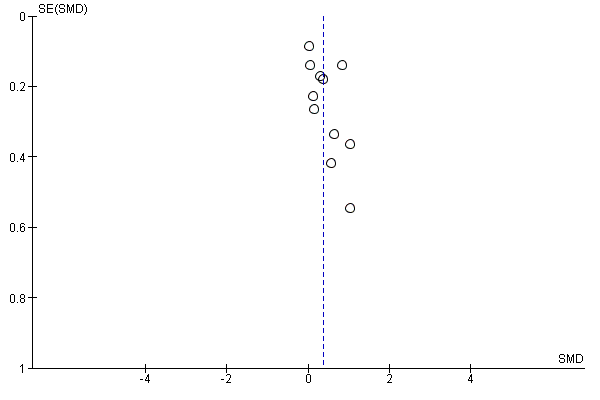
Funnel plot of comparison: 1 Short‐term impact (< 12 months) of child feeding intervention versus no intervention on child consumption of target fruit or vegetable, outcome: 1.1 Fruit and/or vegetable intake.

Funnel plot of comparison: 3 Short‐term impact (< 12 months) of parent nutrition education intervention versus usual care., outcome: 3.1 Fruit and/or vegetable intake.
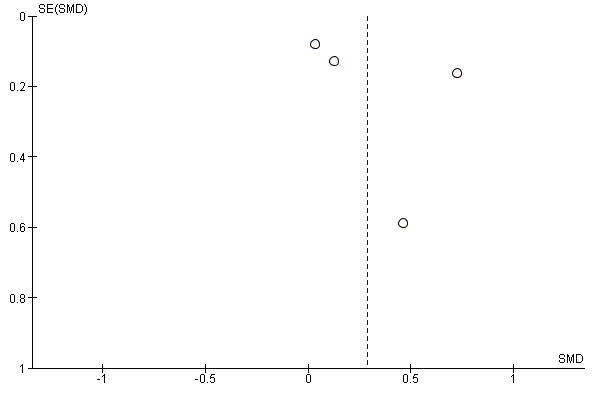
Funnel plot of comparison: 4 Short‐term impact (< 12 months) of multicomponent intervention versus usual care, outcome: 4.1 Fruit and/or vegetable intake.

Comparison 1 Short‐term impact (< 12 months) of child feeding intervention versus no intervention, Outcome 1 Vegetable intake.
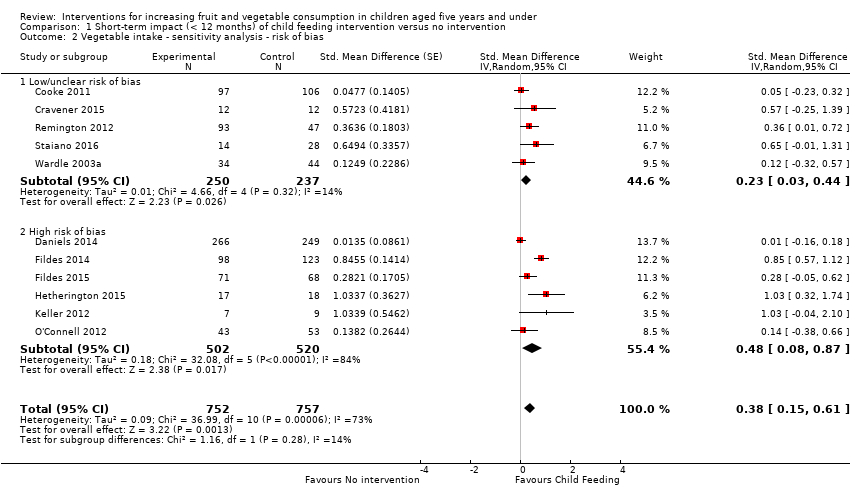
Comparison 1 Short‐term impact (< 12 months) of child feeding intervention versus no intervention, Outcome 2 Vegetable intake ‐ sensitivity analysis ‐ risk of bias.
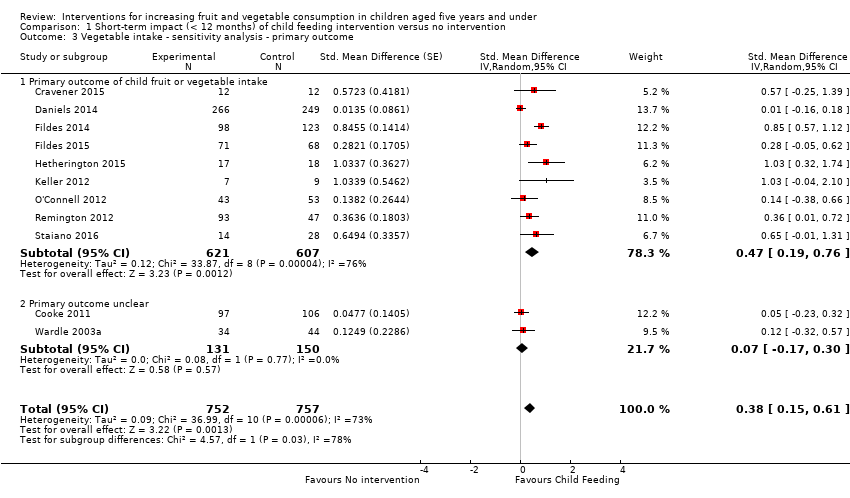
Comparison 1 Short‐term impact (< 12 months) of child feeding intervention versus no intervention, Outcome 3 Vegetable intake ‐ sensitivity analysis ‐ primary outcome.

Comparison 1 Short‐term impact (< 12 months) of child feeding intervention versus no intervention, Outcome 4 Vegetable intake ‐ sensitivity analysis ‐ missing data.
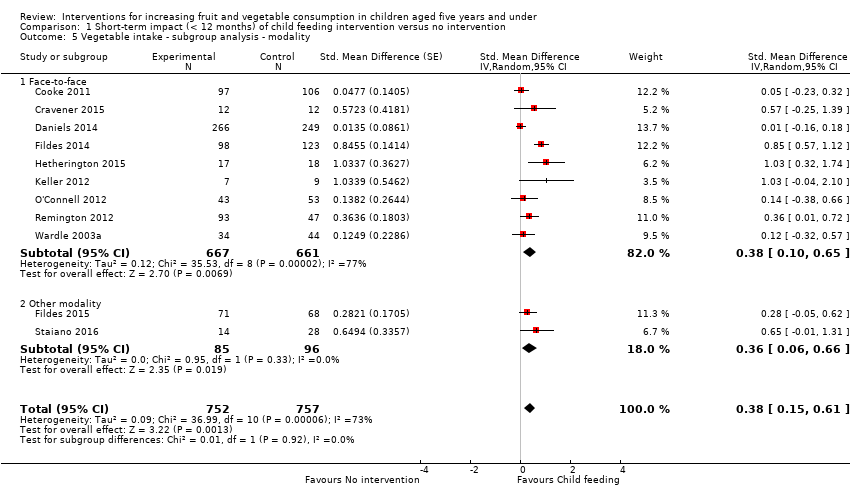
Comparison 1 Short‐term impact (< 12 months) of child feeding intervention versus no intervention, Outcome 5 Vegetable intake ‐ subgroup analysis ‐ modality.

Comparison 1 Short‐term impact (< 12 months) of child feeding intervention versus no intervention, Outcome 6 Vegetable intake ‐ subgroup analysis ‐ setting.
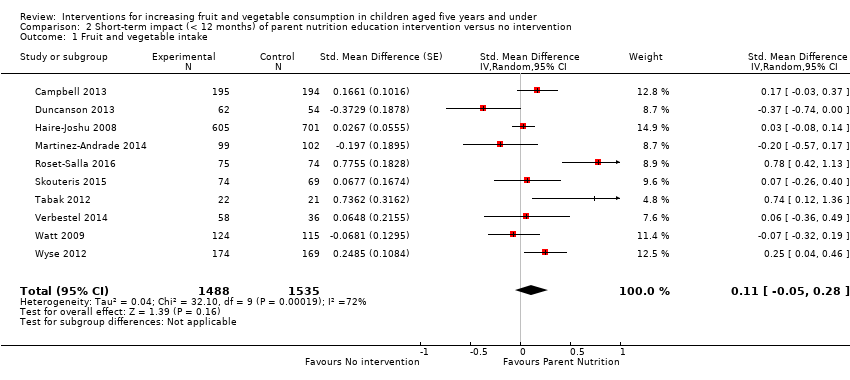
Comparison 2 Short‐term impact (< 12 months) of parent nutrition education intervention versus no intervention, Outcome 1 Fruit and vegetable intake.
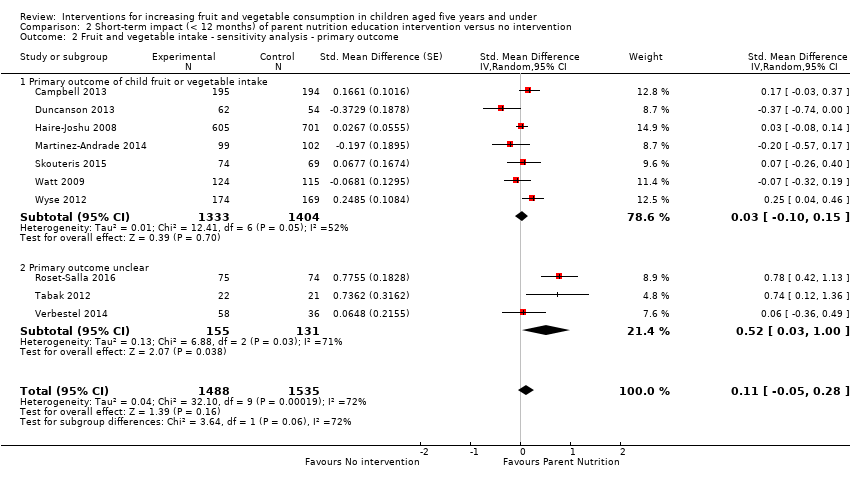
Comparison 2 Short‐term impact (< 12 months) of parent nutrition education intervention versus no intervention, Outcome 2 Fruit and vegetable intake ‐ sensitivity analysis ‐ primary outcome.

Comparison 2 Short‐term impact (< 12 months) of parent nutrition education intervention versus no intervention, Outcome 3 Fruit and vegetable intake ‐ sensitivity analysis ‐ missing data.

Comparison 2 Short‐term impact (< 12 months) of parent nutrition education intervention versus no intervention, Outcome 4 Fruit and vegetable intake ‐ subgroup analysis ‐ modality.

Comparison 2 Short‐term impact (< 12 months) of parent nutrition education intervention versus no intervention, Outcome 5 Fruit and vegetable intake ‐ subgroup analysis ‐ setting.

Comparison 3 Short‐term impact (< 12 months) of multicomponent intervention versus no intervention, Outcome 1 Fruit and vegetable intake.

Comparison 3 Short‐term impact (< 12 months) of multicomponent intervention versus no intervention, Outcome 2 Fruit and vegetable intake ‐ sensitivity analysis ‐ primary outcome.

Comparison 3 Short‐term impact (< 12 months) of multicomponent intervention versus no intervention, Outcome 3 Fruit and vegetable intake ‐ sensitivity analysis ‐ missing data.

Comparison 3 Short‐term impact (< 12 months) of multicomponent intervention versus no intervention, Outcome 4 Fruit and vegetable intake ‐ subgroup analysis ‐ setting.
| Child feeding interventions compared to no intervention for children aged 5 years and under | ||||||
| Patient or population: children aged 5 years and under | ||||||
| Outcomes | Anticipated absolute effects* (95% CI) | Relative effect | № of participants | Quality of the evidence | Comments | |
| Risk with no intervention | Risk with Child feeding interventions | |||||
| Short‐term impact (< 12 months) child vegetable intake | The mean vegetable intake was 7.7 grams1 | The mean vegetable intake (grams) in the intervention group was 4.03 higher (1.59 higher to 6.47 higher) | ‐ | 1509 | ⊕⊝⊝⊝ | Scores estimated using a standardised mean difference of 0.38 (0.15 to 0.61) and a standard deviation of 10.61.1 The mean duration of follow up post‐intervention for studies included in the meta‐analysis was 4.6 weeks. 2 studies that compared 1 or more child‐feeding practice interventions to a no‐treatment control could not be synthesised in meta‐analysis; both reported a significant increase in fruit or vegetables or both |
| Short‐term impact (< 12 months) cost effectiveness ‐ not reported | No child feeding interventions reported this outcome | ‐ | ‐ | ‐ | ‐ | |
| Short‐term impact (< 12 months) unintended adverse events | One trial (Spill 2011a) reported no adverse effects on amount of meal consumed | ‐ | 39 | ⊕⊝⊝⊝ | ‐ | |
| *The risk in the intervention group (and its 95% confidence interval) is based on the assumed risk in the comparison group and the relative effect of the intervention (and its 95% CI) | ||||||
| GRADE Working Group grades of evidence | ||||||
| 1We used the post‐intervention mean and standard deviation of the control group from Wardle 2003a for the risk with no intervention and to re‐express the SMD in terms of grams of intake. | ||||||
| Parent nutrition education interventions compared to no intervention for children aged 5 years and under | ||||||
| Patient or population: children aged 5 years and under | ||||||
| Outcomes | Anticipated absolute effects* (95% CI) | Relative effect | № of participants | Quality of the evidence | Comments | |
| Risk with no intervention | Risk with Parent nutrition education interventions | |||||
| Short‐term impact (< 12 months) child fruit and vegetable intake | The mean serves of vegetables per day was 1.61 | The mean serves of vegetables per day in the intervention group was 0.11 higher (0.05 lower to 0.28 higher) | ‐ | 3023 | ⊕⊝⊝⊝ | Scores estimated using a standardised mean difference of 0.11 (‐0.05 to 0.28) and a standard deviation of 1.01 The mean duration of follow up post‐intervention for studies included in the meta‐analysis was 9.8 weeks. 1 trial could not be pooled in the meta‐analysis; it found an intervention targeting parent responsivity and behaviour management to be effective in increasing total fruit intake compared to control |
| Short‐term impact (< 12 months) cost effectiveness | Information regarding intervention costs was reported in 1 trial (Campbell 2013) | ‐ | 389 | ⊕⊝⊝⊝ | ‐ | |
| Short‐term impact (< 12 months) unintended adverse events | One trial (Wyse 2012) reported no adverse effect on family food expenditure | ‐ | 343 | ⊕⊝⊝⊝ | ||
| *The risk in the intervention group (and its 95% confidence interval) is based on the assumed risk in the comparison group and the relative effect of the intervention (and its 95% CI). | ||||||
| GRADE Working Group grades of evidence | ||||||
| 1We used the post‐intervention mean and standard deviation of the control group from Skouteris 2015 for the risk with no intervention and to re‐express the SMD in terms of serves of vegetables per day. | ||||||
| Multicomponent interventions compared to no intervention for children aged 5 years and under | ||||||
| Patient or population: children aged 5 years and under | ||||||
| Outcomes | Anticipated absolute effects* (95% CI) | Relative effect | № of participants | Quality of the evidence | Comments | |
| Risk with no intervention | Risk with Multicomponent interventions | |||||
| Short‐term impact (< 12 months) child fruit and vegetable intake | The mean cups of vegetables per day was 1.081 | The mean cups of vegetables per day in the intervention group was 0.29 higher (0.06 lower to 0.66 higher) | ‐ | 1861 | ⊕⊝⊝⊝ | Scores estimated using a standardised mean difference of 0.28 (‐0.06 to 0.63) and a standard deviation of 1.051 The mean duration of follow up post‐intervention for studies included in the meta‐analysis was 1.3 weeks. 4 studies could not be pooled in meta‐analysis. 3 reported significant increases in both fruit and vegetable consumption, and 1 significantly increased fruit but not vegetable consumption |
| Short‐term impact (< 12 months) cost effectiveness ‐ not reported | No studies reported this outcome | ‐ | ‐ | ‐ | ‐ | |
| Short‐term impact (< 12 months) unintended adverse events ‐ not reported | No studies reported this outcome | ‐ | ‐ | ‐ | ‐ | |
| *The risk in the intervention group (and its 95% confidence interval) is based on the assumed risk in the comparison group and the relative effect of the intervention (and its 95% CI). | ||||||
| GRADE Working Group grades of evidence | ||||||
| 1We used the post‐intervention mean and standard deviation of the control group from Williams 2014 for the risk with no intervention and to re‐express the SMD in terms of cups vegetables per day. | ||||||
| Child nutrition education interventions compared to no intervention for children aged 5 years and under | ||||||
| Patient or population: children aged 5 years and under | ||||||
| Outcomes | Anticipated absolute effects* (95% CI) | Relative effect | № of participants | Quality of the evidence | Comments | |
| Risk with no intervention | Risk with Child nutrition education interventions | |||||
| Short‐term impact (< 12 months) child fruit and vegetable intake | The mean short‐term impact (< 12 months) child vegetable intake frequency score was 4 (a score of 4 corresponds to consumption of vegetables 3 ‐ 4 times per week) | MD 0 | ‐ | 238 | ⊕⊕⊝⊝ | The only study (Baskale 2011) reported an increase in some of the fruits and vegetables assessed in the intervention group and no significant differences in the control group The duration of follow up post‐intervention was 8 weeks. |
| Cost or cost effectiveness ‐ not reported | No studies reported this outcome | ‐ | ‐ | ‐ | ‐ | |
| Unintended adverse events ‐ not reported | No studies reported this outcome | ‐ | ‐ | ‐ | ‐ | |
| *The risk in the intervention group (and its 95% confidence interval) is based on the assumed risk in the comparison group and the relative effect of the intervention (and its 95% CI). | ||||||
| GRADE Working Group grades of evidence | ||||||
| 1Downgraded one level for risk of bias: high risk of bias due to lack of blinding and loss to follow‐up. | ||||||
| Outcome or subgroup title | No. of studies | No. of participants | Statistical method | Effect size |
| 1 Vegetable intake Show forest plot | 11 | 1509 | Std. Mean Difference (Random, 95% CI) | 0.38 [0.15, 0.61] |
| 2 Vegetable intake ‐ sensitivity analysis ‐ risk of bias Show forest plot | 11 | 1509 | Std. Mean Difference (Random, 95% CI) | 0.38 [0.15, 0.61] |
| 2.1 Low/unclear risk of bias | 5 | 487 | Std. Mean Difference (Random, 95% CI) | 0.23 [0.03, 0.44] |
| 2.2 High risk of bias | 6 | 1022 | Std. Mean Difference (Random, 95% CI) | 0.48 [0.08, 0.87] |
| 3 Vegetable intake ‐ sensitivity analysis ‐ primary outcome Show forest plot | 11 | 1509 | Std. Mean Difference (Random, 95% CI) | 0.38 [0.15, 0.61] |
| 3.1 Primary outcome of child fruit or vegetable intake | 9 | 1228 | Std. Mean Difference (Random, 95% CI) | 0.47 [0.19, 0.76] |
| 3.2 Primary outcome unclear | 2 | 281 | Std. Mean Difference (Random, 95% CI) | 0.07 [‐0.17, 0.30] |
| 4 Vegetable intake ‐ sensitivity analysis ‐ missing data Show forest plot | 11 | 1509 | Std. Mean Difference (Random, 95% CI) | 0.38 [0.15, 0.61] |
| 4.1 Low attrition or high attrition with ITT analysis | 8 | 757 | Std. Mean Difference (Random, 95% CI) | 0.29 [0.10, 0.48] |
| 4.2 High attrition and no ITT analysis | 3 | 752 | Std. Mean Difference (Random, 95% CI) | 0.55 [‐0.16, 1.27] |
| 5 Vegetable intake ‐ subgroup analysis ‐ modality Show forest plot | 11 | 1509 | Std. Mean Difference (Random, 95% CI) | 0.38 [0.15, 0.61] |
| 5.1 Face‐to‐face | 9 | 1328 | Std. Mean Difference (Random, 95% CI) | 0.38 [0.10, 0.65] |
| 5.2 Other modality | 2 | 181 | Std. Mean Difference (Random, 95% CI) | 0.36 [0.06, 0.66] |
| 6 Vegetable intake ‐ subgroup analysis ‐ setting Show forest plot | 11 | 1509 | Std. Mean Difference (Random, 95% CI) | 0.38 [0.15, 0.61] |
| 6.1 School or preschool | 3 | 341 | Std. Mean Difference (Random, 95% CI) | 0.18 [‐0.12, 0.47] |
| 6.2 Home | 4 | 474 | Std. Mean Difference (Random, 95% CI) | 0.56 [0.18, 0.95] |
| 6.3 Home + Lab | 2 | 40 | Std. Mean Difference (Random, 95% CI) | 0.74 [0.09, 1.39] |
| 6.4 Other settings | 2 | 654 | Std. Mean Difference (Random, 95% CI) | 0.11 [‐0.14, 0.36] |
| Outcome or subgroup title | No. of studies | No. of participants | Statistical method | Effect size |
| 1 Fruit and vegetable intake Show forest plot | 10 | 3023 | Std. Mean Difference (Random, 95% CI) | 0.11 [‐0.05, 0.28] |
| 2 Fruit and vegetable intake ‐ sensitivity analysis ‐ primary outcome Show forest plot | 10 | 3023 | Std. Mean Difference (Random, 95% CI) | 0.11 [‐0.05, 0.28] |
| 2.1 Primary outcome of child fruit or vegetable intake | 7 | 2737 | Std. Mean Difference (Random, 95% CI) | 0.03 [‐0.10, 0.15] |
| 2.2 Primary outcome unclear | 3 | 286 | Std. Mean Difference (Random, 95% CI) | 0.52 [0.03, 1.00] |
| 3 Fruit and vegetable intake ‐ sensitivity analysis ‐ missing data Show forest plot | 10 | 3023 | Std. Mean Difference (Random, 95% CI) | 0.11 [‐0.05, 0.28] |
| 3.1 Low attrition or high attrition with ITT analysis | 6 | 2463 | Std. Mean Difference (Random, 95% CI) | 0.11 [‐0.02, 0.24] |
| 3.2 High attrition and no ITT analysis | 4 | 560 | Std. Mean Difference (Random, 95% CI) | 0.07 [‐0.45, 0.59] |
| 4 Fruit and vegetable intake ‐ subgroup analysis ‐ modality Show forest plot | 10 | 3023 | Std. Mean Difference (Random, 95% CI) | 0.11 [‐0.05, 0.28] |
| 4.1 Face‐to‐face only | 5 | 826 | Std. Mean Difference (Random, 95% CI) | 0.12 [‐0.20, 0.45] |
| 4.2 Audio visual only | 2 | 386 | Std. Mean Difference (Random, 95% CI) | 0.40 [‐0.04, 0.85] |
| 4.3 Other modality | 3 | 1811 | Std. Mean Difference (Random, 95% CI) | ‐0.00 [‐0.22, 0.21] |
| 5 Fruit and vegetable intake ‐ subgroup analysis ‐ setting Show forest plot | 10 | 3023 | Std. Mean Difference (Random, 95% CI) | 0.11 [‐0.05, 0.28] |
| 5.1 Home | 5 | 2047 | Std. Mean Difference (Random, 95% CI) | 0.06 [‐0.16, 0.27] |
| 5.2 Preschool | 2 | 243 | Std. Mean Difference (Random, 95% CI) | 0.43 [‐0.27, 1.13] |
| 5.3 Other settings | 3 | 733 | Std. Mean Difference (Random, 95% CI) | 0.06 [‐0.14, 0.26] |
| Outcome or subgroup title | No. of studies | No. of participants | Statistical method | Effect size |
| 1 Fruit and vegetable intake Show forest plot | 4 | 1861 | Std. Mean Difference (Random, 95% CI) | 0.28 [‐0.06, 0.63] |
| 2 Fruit and vegetable intake ‐ sensitivity analysis ‐ primary outcome Show forest plot | 4 | 1861 | Std. Mean Difference (Random, 95% CI) | 0.28 [‐0.06, 0.63] |
| 2.1 Primary outcome of child fruit or vegetable intake | 3 | 1167 | Std. Mean Difference (Random, 95% CI) | 0.38 [‐0.20, 0.95] |
| 2.2 Primary outcome unclear | 1 | 694 | Std. Mean Difference (Random, 95% CI) | 0.12 [‐0.13, 0.38] |
| 3 Fruit and vegetable intake ‐ sensitivity analysis ‐ missing data Show forest plot | 4 | 1861 | Std. Mean Difference (Random, 95% CI) | 0.28 [‐0.06, 0.63] |
| 3.1 Low attrition or high attrition with ITT analysis | 2 | 265 | Std. Mean Difference (Random, 95% CI) | 0.70 [0.39, 1.01] |
| 3.2 High attrition and no ITT analysis | 2 | 1596 | Std. Mean Difference (Random, 95% CI) | 0.06 [‐0.08, 0.20] |
| 4 Fruit and vegetable intake ‐ subgroup analysis ‐ setting Show forest plot | 4 | 1861 | Std. Mean Difference (Random, 95% CI) | 0.28 [‐0.06, 0.63] |
| 4.1 School or preschool | 3 | 1608 | Std. Mean Difference (Random, 95% CI) | 0.07 [‐0.07, 0.20] |
| 4.2 Other settings | 1 | 253 | Std. Mean Difference (Random, 95% CI) | 0.72 [0.40, 1.04] |

